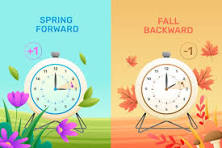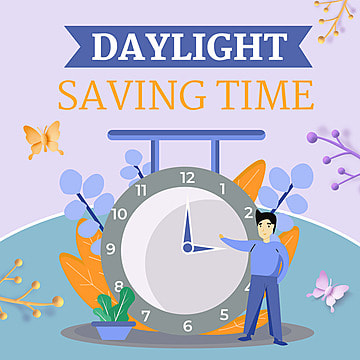It’s Time to Fall Back:
Daylight Saving Time Ends in New York on November 3rd, 2024

Attention New Yorkers! As the leaves change color and the days grow shorter, it’s time to prepare for the end of Daylight Saving Time (DST). This year, on Sunday, November 3rd, 2024, at 2:00 am, clocks will be set back one hour, marking the official transition to standard time.
Many people use the phrase “fall back” to remember this time change. It means that while you might lose an hour of sleep that night (because 2:00 am simply won’t exist!), you’ll gain an extra hour of sunlight in the mornings for the rest of the fall and winter.
Here’s a quick rundown of what you need to know:
- When: Sunday, November 3rd, 2024 at 2:00 am local time.
- What: Daylight Saving Time ends, and we switch to standard time.
- What to do: Set your clocks back one hour before going to bed on Saturday night, November 2nd. Most electronic devices will update automatically, but don’t forget about your traditional clocks!
FAQs:
- Do we get an extra hour of sleep? Technically, no. Since 2:00 am on November 3rd disappears, you’ll lose that hour of sleep.
- Will the time change affect California? Yes, Daylight Saving Time ends nationwide, including California.
- Is Daylight Saving Time still a thing? As of today, November 3rd, 2024, Daylight Saving Time is still observed in most parts of the United States, including New York. However, there have been discussions about making Daylight Saving Time permanent.
Remember: This is your friendly reminder to adjust your clocks and prepare for the return of standard time. Enjoy the extra morning sunshine and make the most of the beautiful fall season in New York!Sources and related content

DST affects daily life in different countries, comparing a typical summer day:
New York, USA (Observes DST):
- Sunrise without DST would be: 4:30 AM
- Sunrise with DST: 5:30 AM
- People start work at 9:00 AM
- Sunset without DST would be: 7:30 PM
- Sunset with DST: 8:30 PM
- Result: More evening daylight for after-work activities
Tokyo, Japan (Doesn’t observe DST):
Sunrise: 4:30 AM
People start work at 9:00 AM
Sunset: 7:00 PM
Result: Early morning sunlight, but darker evenings
Here’s a practical example of international coordination:
Let’s say you need to schedule a video call between:
- New York (observes DST)
- London (observes DST)
- Tokyo (doesn’t observe DST)
In July:
When it’s 2:00 PM in New York
what is daylight saving time
Daylight Saving Time (DST) is a practice of advancing clocks forward by one hour during warmer months, typically in spring and summer, to extend daylight into the evening hours. The main idea is to make better use of natural daylight and conserve energy.
In most of the United States, DST:
- Begins on the second Sunday in March (“spring forward” – clocks move ahead one hour)
- Ends on the first Sunday in November (“fall back” – clocks move back one hour)
The phrase “spring forward, fall back” is commonly used to help people remember when and how to adjust their clocks.
While DST is observed in many countries, not all regions participate. In the US, Hawaii and most of Arizona (except for the Navajo Nation) don’t observe DST. The practice remains controversial, with ongoing debates about its benefits and drawbacks, including:
Benefits:
- More evening daylight for activities
- Potential energy savings
- Possible reduction in traffic accidents
Drawbacks:
- Sleep disruption
- Potential health impacts
- Confusion and scheduling complications
what time does the time change?
The time change occurs at 2:00 AM local time, both in spring and fall:
Spring Forward (Start of DST)
- Occurs on the second Sunday in March
- At 2:00 AM, clocks suddenly jump to 3:00 AM
- This means you “lose” one hour of sleep
Fall Back (End of DST)
- Occurs on the first Sunday in November
- At 2:00 AM, clocks move back to 1:00 AM
- This means you “gain” an extra hour
For 2024, the specific dates are:
- Spring Forward: Sunday, March 10, 2024 at 2:00 AM
- Fall Back: Sunday, November 3, 2024 at 2:00 AM (today)
The change is scheduled for 2:00 AM because it’s generally when there’s minimal disruption to businesses, transportation schedules, and most people’s sleep patterns, since relatively few people are awake at that hour.
which country people follow it most
The United States and European Union are among the largest populations that widely observe Daylight Saving Time, but the practice varies by region and has changed over time. Here’s how different major regions handle DST:
United States
- About 48 states follow DST (except Hawaii and most of Arizona)
- Approximately 300 million people affected
European Union
- All 27 member countries observe DST uniformly
- Around 450 million people affected
- However, the EU has voted to end mandatory DST, though implementation has been delayed
Canada
- Most provinces observe DST
- Exception: Most of Saskatchewan stays on Standard Time year-round
- About 37 million people affected
Russia
- Used to observe DST but abolished it in 2014
- Now stays on permanent standard time
While the EU technically has more people following DST currently, the United States might be considered the country that “follows it most” in terms of cultural impact and consistency of observation, as it’s been a stable practice there since the Uniform Time Act of 1966. The US also tends to be more committed to maintaining DST, while many other regions are considering abandoning or have already abandoned the practice.
Let me give you an example of how DST affects daily life in different countries, comparing a typical summer day:
New York, USA (Observes DST):
- Sunrise without DST would be: 4:30 AM
- Sunrise with DST: 5:30 AM
- People start work at 9:00 AM
- Sunset without DST would be: 7:30 PM
- Sunset with DST: 8:30 PM
- Result: More evening daylight for after-work activities
Tokyo, Japan (Doesn’t observe DST):
- Sunrise: 4:30 AM
- People start work at 9:00 AM
- Sunset: 7:00 PM
- Result: Early morning sunlight, but darker evenings
Here’s a practical example of international coordination:
Let’s say you need to schedule a video call between:
- New York (observes DST)
- London (observes DST)
- Tokyo (doesn’t observe DST)
In July:
- When it’s 2:00 PM in New York
- It’s 7:00 PM in London
- It’s 3:00 AM next day in Tokyo
But in December:
- When it’s 2:00 PM in New York
- It’s 7:00 PM in London
- It’s 4:00 AM next day in Tokyo
Real-life impact example:
- An American family in Seattle:
- Summer with DST: Can have barbecue until 9:00 PM with daylight
- Winter without DST: Gets dark by 4:30 PM
- A German family in Berlin:
- Summer with DST: Kids can play outside until 9:30 PM
- Winter without DST: Dark by 4:00 PM
- A Japanese family in Tokyo (no DST):
The implementation of Daylight Saving Time (DST) in the USA and EU necessitates biannual adjustments to schedules, significantly impacting daily routines and work patterns. Conversely, countries like Japan, which adhere to a consistent time standard year-round, experience a more stable rhythm. This stark contrast in timekeeping practices underscores the profound influence of DST on individual lifestyles and global communication.



